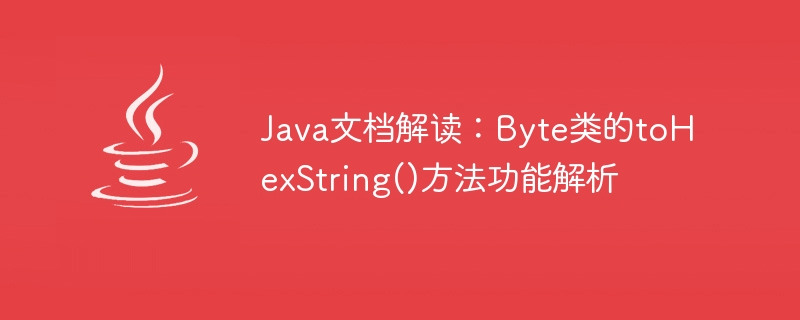Home >Java >javaTutorial >Interpretation of Java documentation: Analysis of the function of toHexString() method of Byte class
Interpretation of Java documentation: Analysis of the function of toHexString() method of Byte class
- WBOYWBOYWBOYWBOYWBOYWBOYWBOYWBOYWBOYWBOYWBOYWBOYWBOriginal
- 2023-11-03 14:18:211331browse

Java Document Interpretation: Function analysis of the toHexString() method of the Byte class requires specific code examples
Introduction:
In Java programming, the Byte class provides Some useful methods for handling byte data. One of them is the toHexString() method, which converts a byte data into a hexadecimal string form. This article will provide a detailed analysis of the toHexString() method of the Byte class and provide specific code examples to help readers better understand its functions and usage.
1. Overview of the toHexString() method of the Byte class
According to the official Java documentation, the function of the toHexString() method of the Byte class is to convert a byte data into a hexadecimal string form. The return value of this method is a two-character string representing the hexadecimal value of a byte.
2. The syntax of toHexString() method
The syntax of toHexString() method is as follows:
public static String toHexString(byte b)
3. toHexString() method Parameter description
The toHexString() method has only one parameter, which is a byte type variable b. This parameter represents the byte data to be converted.
4. The return value of the toHexString() method
The return value of the toHexString() method is a string consisting of two characters, representing the hexadecimal value of the parameter byte.
5. Sample code of toHexString() method
The following is a sample code using toHexString() method:
import java.lang.Byte;
public class Main {
public static void main(String[] args) {
byte b = 127; // 要转换的字节数据
String hexString = Byte.toHexString(b); // 调用toHexString()方法,将字节数据转换成十六进制字符串
System.out.println("字节数据的十六进制表示为:" + hexString);
}}
Run the above code, the following results will be output:
The hexadecimal representation of byte data is: 7f
In the above example In the code, we define a byte variable b and assign it a value of 127. Then, we call the toHexString() method of the Byte class to convert the byte data b into a hexadecimal string form. Finally, we print the results through the System.out.println() method. After running the code, the console will print out "The hexadecimal representation of the byte data is: 7f".
6. Precautions for using toHexString() method
- The toHexString() method is a static method and can be called directly through the class name Byte. There is no need to create an instance object of the Byte class.
- The toHexString() method can only accept one byte of data as a parameter and returns the hexadecimal representation of the byte. If multiple bytes of data are passed in, only the first byte will be taken for conversion.
Conclusion:
Through the above analysis, we understand the function and usage of the toHexString() method of the Byte class. It can conveniently convert a byte data into a hexadecimal string and can play a role in many practical developments. Readers can flexibly apply this method in actual projects according to their own needs.
The above is the detailed content of Interpretation of Java documentation: Analysis of the function of toHexString() method of Byte class. For more information, please follow other related articles on the PHP Chinese website!
Related articles
See more- Interpretation of Java documentation: Usage analysis of getProperties() method of System class
- Interpretation of Java documentation: Analysis of the addFirst() method function of the LinkedList class
- Interpretation of Java documentation: Detailed explanation of the usage of the put() method of the HashMap class
- Interpretation of Java documentation: Functional analysis of toHexString() method of Short class
- Interpretation of Java documentation: Functional analysis of the getLast() method of the LinkedList class

